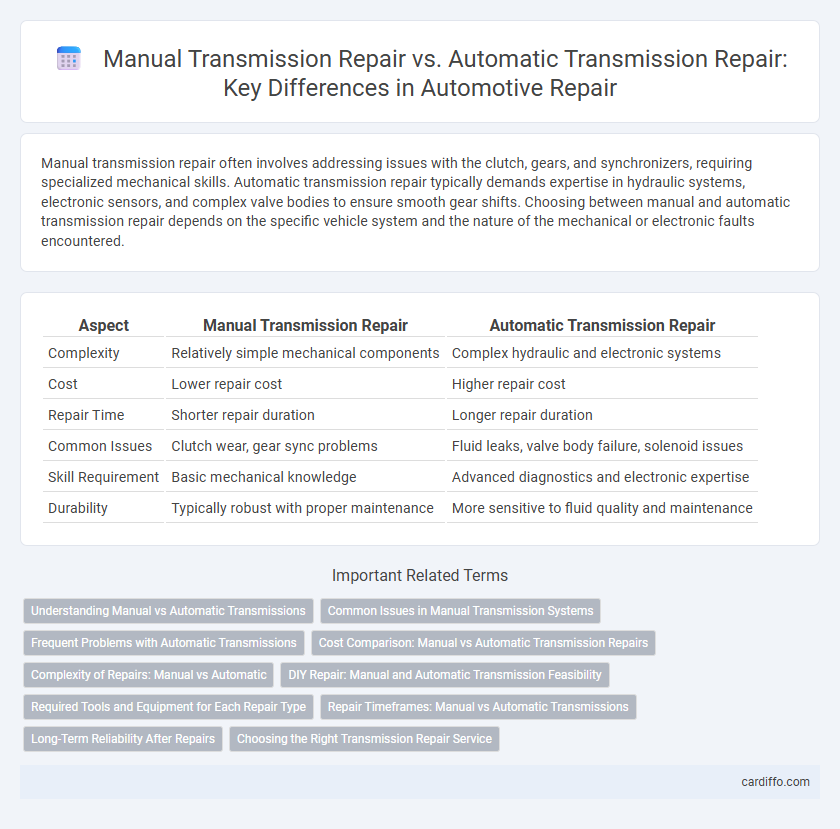Manual transmission repair often involves addressing issues with the clutch, gears, and synchronizers, requiring specialized mechanical skills. Automatic transmission repair typically demands expertise in hydraulic systems, electronic sensors, and complex valve bodies to ensure smooth gear shifts. Choosing between manual and automatic transmission repair depends on the specific vehicle system and the nature of the mechanical or electronic faults encountered.
Table of Comparison
| Aspect | Manual Transmission Repair | Automatic Transmission Repair |
|---|---|---|
| Complexity | Relatively simple mechanical components | Complex hydraulic and electronic systems |
| Cost | Lower repair cost | Higher repair cost |
| Repair Time | Shorter repair duration | Longer repair duration |
| Common Issues | Clutch wear, gear sync problems | Fluid leaks, valve body failure, solenoid issues |
| Skill Requirement | Basic mechanical knowledge | Advanced diagnostics and electronic expertise |
| Durability | Typically robust with proper maintenance | More sensitive to fluid quality and maintenance |
Understanding Manual vs Automatic Transmissions
Manual transmission repair often involves addressing clutch components, gear synchronizers, and shift linkages, requiring specialized knowledge of mechanical linkages and fluid maintenance. In contrast, automatic transmission repair focuses on electronic control systems, hydraulic circuits, and torque converters, which demands expertise in computer diagnostics and fluid dynamics. Understanding the fundamental differences in operation and parts between manual and automatic transmissions is crucial for accurate diagnosis and effective repair strategies.
Common Issues in Manual Transmission Systems
Common issues in manual transmission systems include worn clutch components, such as the clutch disc and pressure plate, leading to slipping or difficulty shifting gears. Synchronizer ring wear often causes grinding noises and gear engagement problems, especially during downshifting. Additionally, problems with the transmission fluid, linkage misalignment, or damaged gears can result in rough shifts and reduced overall transmission performance.
Frequent Problems with Automatic Transmissions
Automatic transmissions often experience frequent issues such as fluid leaks, overheating, and worn clutch packs, leading to poor shifting performance and potential transmission failure. Common problems also include torque converter malfunctions and sensor failures that disrupt smooth gear changes. Regular maintenance and timely repairs are essential to prevent costly damage and extend the lifespan of automatic transmission systems.
Cost Comparison: Manual vs Automatic Transmission Repairs
Manual transmission repairs generally cost less than automatic transmission repairs due to simpler mechanics and fewer components. Automatic transmissions have complex hydraulic systems and electronic controls that increase labor time and parts expenses. On average, manual repair costs range from $1,000 to $1,500, while automatic transmission repairs can exceed $3,000 depending on the extent of damage and model.
Complexity of Repairs: Manual vs Automatic
Manual transmission repair typically involves simpler mechanical components such as clutches and gear linkages, making diagnostics and repairs more straightforward. Automatic transmission repair requires advanced knowledge of hydraulic systems, electronic controls, and torque converters, increasing the complexity and specialized diagnostic tools needed. Technicians often spend more time on automatic transmissions due to intricacies like valve bodies, solenoids, and fluid systems, impacting repair costs and duration.
DIY Repair: Manual and Automatic Transmission Feasibility
DIY repair of manual transmissions is generally more feasible due to their simpler mechanical design, allowing enthusiasts with basic tools and mechanical knowledge to replace clutches or synchronize gears. In contrast, automatic transmission repair involves complex hydraulic systems, electronic controls, and specialized diagnostic equipment, making it challenging for DIY enthusiasts to perform without professional training. Proper manuals, transmission fluid specifications, and access to rebuild kits are essential for any transmission repair project, but the complexity heavily influences the success and safety of DIY efforts.
Required Tools and Equipment for Each Repair Type
Manual transmission repair typically requires specialized tools such as clutch alignment tools, gear pullers, and torque wrenches designed for precise adjustment. Automatic transmission repair demands more advanced diagnostic equipment like scan tools, transmission fluid exchange machines, and valve body testing devices. Proper tooling ensures accurate disassembly, inspection, and reassembly for both transmission types, directly impacting repair quality and vehicle performance.
Repair Timeframes: Manual vs Automatic Transmissions
Manual transmission repair typically requires less time than automatic transmission repair due to simpler mechanical components and fewer complex electronic systems. Automatic transmissions involve intricate hydraulic circuits, sensors, and computerized controls that extend diagnostic and repair timeframes significantly. Repair shops often estimate manual transmission repairs to take between 4 to 8 hours, whereas automatic transmission repairs can require 10 to 20 hours or more depending on the severity of the issue.
Long-Term Reliability After Repairs
Manual transmission repair generally offers greater long-term reliability due to fewer complex components and simpler design, reducing the likelihood of future failures. Automatic transmissions, while more convenient, involve intricate hydraulic systems and electronic controls that may require frequent maintenance and skilled diagnostics to ensure durability after repairs. Choosing expert technicians familiar with specific transmission types significantly enhances the lifespan and performance of both manual and automatic transmissions post-repair.
Choosing the Right Transmission Repair Service
Choosing the right transmission repair service depends on whether your vehicle has a manual or automatic transmission, as each requires specialized expertise and tools. Manual transmission repair often involves clutch replacement and gear synchronization, while automatic transmission repair focuses on hydraulic systems and electronic controls. Selecting a service provider experienced in your specific transmission type ensures accurate diagnostics, quality repairs, and extends your vehicle's lifespan.
Manual transmission repair vs automatic transmission repair Infographic

 cardiffo.com
cardiffo.com